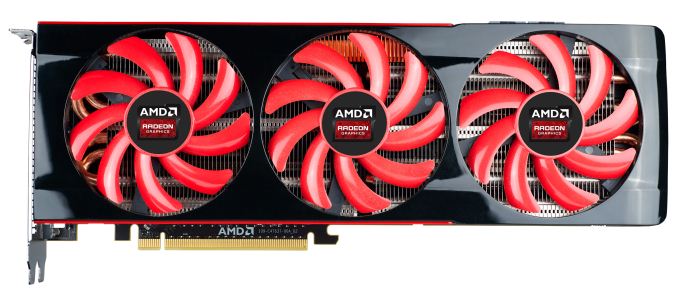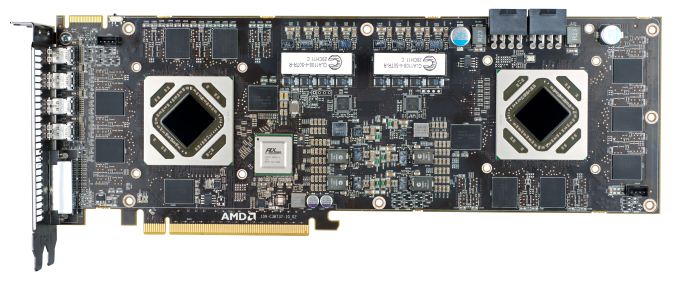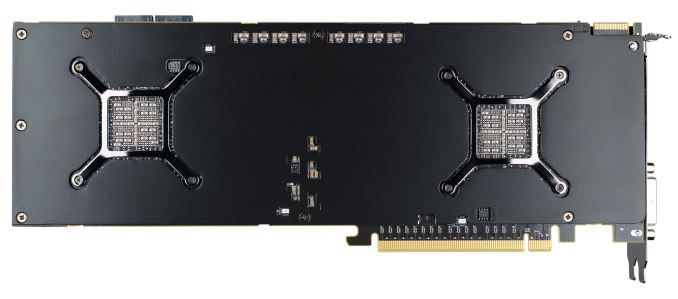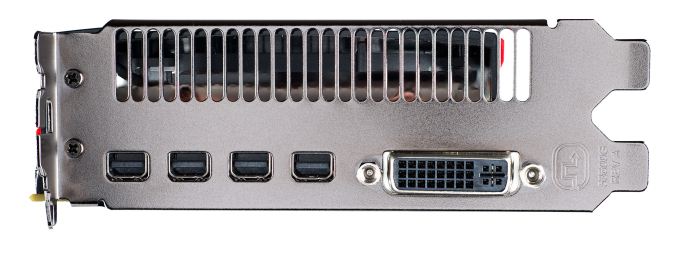AMD Radeon HD 7990 Review: 7990 Gets Official
by Ryan Smith on April 24, 2013 12:01 AM EST- Posted in
- GPUs
- AMD
- Radeon
- Radeon HD 7000
- Tahiti
Meet The Radeon HD 7990
Having taken a look at the specifications for the 7990 we can finally dive into the 7990’s features and construction. AMD isn’t going to try to match NVIDIA’s over the top luxury finish for GTX 690 and GTX Titan, but they have still been able to put together a very solid card.
It’s interesting to note that with the 7990 AMD has now cycled through all 3 styles of coolers on their dual-GPU cards. The 5870X2 was a straight-on blower, and the 6990 that followed it was a half-blower that pushed hot air out of both the front and the rear of the card. For the 7990 however AMD has dropped the blowers entirely for a completely open air design.
Traditionally high-end cards have been the domain of blowers due to the amount of heat they put out, but over the last few years open air coolers have been creeping further and further up manufacturers’ product stacks. The tradeoff between the two being that while blowers are self-sustaining and ensure all hot air is expelled by the card – or at least half of the hot air in the case of half-blowers – open air coolers move more of the work to the chassis in exchange for generally lower noise levels. There is no right or wrong way to go about this, but this ends up being quite interesting since this is the first time we’ve seen a reference card over 225W use an open air cooler.
Coming from the 6990, this is probably the most sensible move for AMD to make. The 6990 had a very powerful cooler that unfortunately was also very loud under full load. The 6990 was a bit of an oddity since AMD went out of their way to build in a great deal of overclocking headroom, but they paid with noise. The 7990 in many ways is a reflection and a correction of that, shifting from focusing on overclocking to focusing on noise, and hence the move to an open air cooler.
At the same time this change does mean that the chassis/case used becomes more important than ever. Of the 375W of heat generated by the 7990, only a fraction of it will be kicked out via its vent; the rest will be dumped into the case. Cooling the 7990 in this manner won’t take anything exotic, but an airy case is a must with a top-mounted exhaust being particularly helpful. In a good case the 7990 will have to do very little work on its own, leaving most of the work up to the much larger and quieter 120mm/140mm/240mm fans found on modern cases.
Moving on, as an open air cooler the 7990’s cooling system is ultimately composed of 3 85mm fans positioned over a pair of heatsinks (one for each GPU) that effectively run the length of the card. Around those heatsinks is another grooved heatplate that serves to channel airflow while drawing heat off of the RAM, VRMs, and PLX bridge. If you’ve seen some of our other reviews of high end custom video cards in the past you’ll recognize this kind of setup as being nothing new, but it’s one that has proven very effective. The overall length of the card ends up being 12” (the same as the 6990) giving AMD plenty of room to mount their fans and heatsinks.
Drilling down, we can see the 7990 PCB and components in all of their glory. The two Tahiti GPUs are joined by 3GB of Hynix 6GHz GDDR5 RAM – the other 3GB is on the back – and a PLX PCIe 3.0 bridge that provides connectivity between the GPUs and the PCIe connector. Elsewhere we can see that our earlier hunch was correct and that AMD is using Volterra VRMs throughout the 7990; this replaces the CHiL VRMs found on AMD’s single-GPU 7900 series reference cards. Not seen here is the high performance phase change TIM AMD is once again using for the 7990, so like the 6990 the 7990 is not meant for disassembly unless the cooler is being completely replaced.
As for the back side of the card, backplates are back. The thermal benefits are marginal since GDDR5 doesn’t require much in the way of cooling, but since the 7990 requires at least one slot’s worth of free space for breathing room anyhow, AMD doesn’t need to worry about tightly packed 7990s and can add a backplate to protect the card and make it easier to handle. Looking at the back also gives us a clear view of the card’s BIOS switch. There’s no “AWSUM” mode this time, so the switch just provides a backup BIOS as it does on the other 7900 series cards. Also present are the two 8pin PCIe power sockets necessary to allow the card to pull 375W it needs to operate, along with 1 CrossFire connector to allow the 7990 to be paired with another 7990 for quad-GPU usage.
Coming around to the I/O bracket, AMD has split their slots between ventilation at the top and display outputs at the bottom. The 7990 uses the same output configuration as the 6990: 4 mini-DPs, and 1 DL-DVI port. DL-DVI continues to stubbornly stick around, particularly with the rise of cheap Korean IPS displays, so at nearly $100 for a DP to DL-DVI adapter AMD needs to keep a DVI port. The end result is that the 7990 can still drive 5 displays, so a 5x1 Eyefinity setup can be driven off of the 7990 with no further equipment required. Alternatively, by packing in multiple DisplayPorts AMD can drive multiple 4K displays once DP-equipped variants of those displays start arriving.
Altogether the 7990 is not too different from some of the other large open air cooled cards we’ve seen in the past, which should bode well for AMD given how well these cards work. Though perhaps AMD’s biggest advantage here is that with the greatly reduced power consumption of their 7990 over the earlier unofficial cards, they’re able to pull off in a double-wide card what took PowerColor a triple-wide, and Asus a closed loop water cooled.





















91 Comments
View All Comments
Torrijos - Wednesday, April 24, 2013 - link
I guess you didn't understand me!My point is, no matter the excuse, if FCAT results weren't available to provide the potential consumers with the proper information on what he would be purchasing, the article shouldn't have been published.
They say the results are coming in a week...
Good! Let's wait a week.
Instead we get superlatives and plots about how great the card is doing, except that some other site (PCPer) had the time to present FCAT result and as of right now you would be trowing money out the window.
Good news though that same site tests the experimental drivers and show that AMD might be on a path to a solution, BUT no release date for that driver, so NO IDEA WHEN this 1k$ card would FINALLY be useful!
There is no excuse, if you have an ounce of scientific integrity, to present a paper/article without the proper data. That is embarrassing!
rocky12345 - Wednesday, April 24, 2013 - link
What I find funny is that a year ago you would have taken these numbers & most likely ran to the store with cash in hand to be the first in line to buy one of these cards. But because someone somewhere was bored & decided that straight Frame rate numbers was so 90's & decided to make some crap software that breaks things down to each & every frame you now can not decide if a card is good or not withoout these fcat numbers. If any given card produces smooth frame rate in a game at the monitors res & refresh then it is a good card. But if all your looking at is unlocking the refresh & spending all of your time bench testing then enjoy your beloved fcat. myself I tend to enjoy actually playing the games I will let others spend their time worrying about the fcat numbers if that is all that is important to them.Like I said if a given card can hold its frames at my monitors refresh then that is all thats important.
rocky12345 - Thursday, April 25, 2013 - link
I may have been a bit harsh in my last post. I went to that site read the review on the 7990 & then read the fallow up review about the prototype 2 drivers http://www.pcper.com/reviews/Graphics-Cards/Frame-... and AMD is indeed on the right path on sorting this out.I myself have never noticed these issues in my games because I am normally to involved in the action or story to notice the tiny glitches or runt frames as everyone is pointing out.
Klimax - Wednesday, April 24, 2013 - link
I'd like to ask what mode was Titan in for compute tests? Was it Single or double precision. (Can't test it yet unfortunately as I do have Titan myself)Ryan Smith - Wednesday, April 24, 2013 - link
SP mode for everything except FAH's double precision tests.yannigr - Wednesday, April 24, 2013 - link
No comment about the game bundle in the conclusion? 8(not one or two) NEW and FREE and TOP(most of them) games don't count when deciding about a $999 card? I don't think that everyone is downloading games from torrents.A5 - Wednesday, April 24, 2013 - link
There's a comment earlier. It's not really worth mentioning in the conclusion.R0H1T - Wednesday, April 24, 2013 - link
I'd think that over the lifetime of this card one would/could easily recuperate his/her expenditure with bitcoins & as such given the possible improvements in performance especially with future driver updates this dual GPU card is a much better deal over the titan or GTX 690, again over a long(er) period of time not counting the short term drawbacks !A5 - Wednesday, April 24, 2013 - link
Don't peg your cost/benefit analysis to Bitcoins. That's dumb.R0H1T - Wednesday, April 24, 2013 - link
Umm did you miss the part where the game bundle is worth ~350 $ in itself ? The bitcoin mining is an added advantage & unless you think its asinine for one to go down that route, FYI the bundled games are also resold, it's disingenuous for anyone to suggest that mining bitcoin isn't worth it !